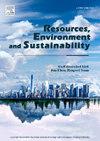Nitrogen reduction with green manure roots return maintains spring wheat yield and alleviates soil N2O emission in saline-alkali agroecosystem
IF 12.4
Q1 ENVIRONMENTAL SCIENCES
引用次数: 0
Abstract
The growing global demand for grain drives a greater need for nitrogen (N) input. Yet, it contributes to nitrous oxide (O) emissions, aggravating global climate change. To tackle this dual challenge of fulfilling crop demands while maintaining or reducing O emissions, a field study was performed in wheat-green manure cropping system to assess the effects of varying fertilizer application (N100, N90 and N80: N fertilizer reduced by 0%, 10% and 20%) combined with green manure return strategy (GMR: green manure roots return, GMRS: green manure roots and shoots return), and wheat fallow after harvest (CK) on wheat yield and yield stability from 2020 to 2024, O emissions, as well as O emission intensity from 2022 to 2024. Results showed that, although N fertilizer combined with green manure return strategy increased spring wheat yield by 8%–22% by increasing soil mineral N contents, it decreased yield stability compared with CK. Soil O emissions were mainly negatively and positively regulated by pH and NO-N content in saline-alkali soil, respectively. N80 decreased cumulative soil O emission and O intensity by 20% and 10% compared with N100, respectively. Irrespective of the variations in N fertilizer levels, GMR decreased cumulative O emission and O intensity by 20%–34% and 22%–38% compared with GMRS, respectively. Overall, the findings highlighted N fertilizer reduced by 20% (160 kg N ha −1) with green manure roots returned in relative to normal rate (200 kg N ha −1) is a viable option to ensure spring wheat yield and alleviate soil O emission in saline-alkali agroecosystem.

绿肥还根降氮维持了春小麦产量,缓解了盐碱农业生态系统土壤N2O排放
全球粮食需求的增长推动了对氮(N)投入的更大需求。然而,它导致一氧化二氮(N2O)排放,加剧了全球气候变化。为了解决在满足作物需求的同时保持或减少N2O排放的双重挑战,在小麦-绿肥种植系统中进行了一项实地研究,以评估不同施肥(N100、N90和N80:氮肥减少0%、10%和20%)与绿肥返还策略(GMR:绿肥根返还,GMRS:绿肥根、芽回归)和小麦收获后休耕(CK)对2020 - 2024年小麦产量及产量稳定性、2022 - 2024年N2O排放及N2O排放强度的影响。结果表明,虽然氮肥配绿肥还田策略通过提高土壤矿质氮含量使春小麦产量提高8% ~ 22%,但与对照相比,其产量稳定性下降。盐碱地土壤N2O排放主要受pH和NO3−-N含量的负向和正向调节。与N100相比,N80使土壤累积N2O排放量和N2O强度分别降低20%和10%。无论氮肥水平如何变化,与GMR相比,GMR的累积N2O排放量和N2O强度分别降低了20% ~ 34%和22% ~ 38%。总体而言,研究结果表明,在盐碱农业生态系统中,减少20%的氮肥(160 kg N ha - 1),同时以正常水平(200 kg N ha - 1)还根,是保证春小麦产量和减少土壤N2O排放的可行选择。
本文章由计算机程序翻译,如有差异,请以英文原文为准。
求助全文
约1分钟内获得全文
求助全文
来源期刊

Resources Environment and Sustainability
Environmental Science-Environmental Science (miscellaneous)
CiteScore
15.10
自引率
0.00%
发文量
41
审稿时长
33 days
 求助内容:
求助内容: 应助结果提醒方式:
应助结果提醒方式:


